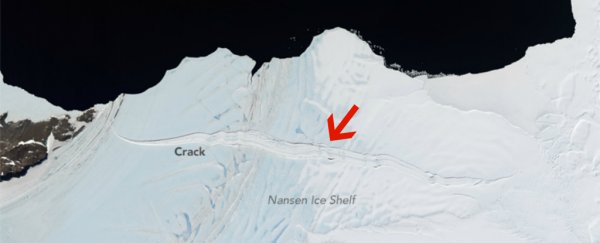NASA scientists have spotted a giant, 50-km-long crack forming across one of Antarctica's ice shelves, prompting concerns that it might soon break off and produce an iceberg - or series of icebergs - roughly twice the size of Manhattan.
The good news is that ice shelves don't produce sea level rise just by breaking away - they're already floating ice shelves that are simply attached to the perimeter of Antarctica. But the bad news is that, when they're attached, they slow down ice loss from the centre of the continent, and when that process speeds up, it does contribute to sea level rise.
The crack was first spotted back in December 2013 by the Landsat 8 satellite, and is located on the Nansen Ice Shelf, which is around 35-km across and 50-km long, and situated on the Southern Ocean's Terra Nova Bay.
At the end of last year, NASA scientists Christine Dow and Ryan Walker visited the ice shelf to install GPS stations on it to track how it was affected by tides. And when they flew across the area, they quickly realised that the crack had become a lot bigger over the past two years - now almost stretching the entire length of the Nansen Ice Shelf.
"There's a huge crack, miles long and sometimes over a hundred yards wide, which runs more or less parallel to the front of the ice shelf," Walker wrote in a blog post when he got back. "Over the winter, the sea surface freezes and traps small icebergs in the crack, producing a fascinatingly broken ices cape."
 NASA Earth Observatory
NASA Earth Observatory
As of the start of this month, satellite imagery shows that the ice shelf is still attached to the continent, and coming into south-coast winter it's got a better chance of hanging on. But ice shelves can still break way, regardless of the temperature.
"Even in winter, strong winds can prevent the water beyond the shelf from freezing, so it is unclear whether the front will separate soon or hang on like a loose tooth," writes NASA's Earth Observatory.
So why is this happening? Ice shelves break off and often reform regularly, and it's not always a result of climate change - tides and ocean currents can also play a role. But several iconic ice-shelf disintegrations, such as the Serson Ice Shelf in northern Canada, have been linked to increasing temperatures.
And the rate of ice shelf loss has also been speeding up. Over the past 20 years, Antarctica's Larsen Ice Shelves has pretty much decreased significantly, losing 75 percent of its area.
The icebergs produced by these types of events don't just pose threats to boats that get in their way, but also to marine life - such as the 150,000 penguins that died at the start of this year when an iceberg blocked their path to the sea, cutting off their food supply.
There's still a lot we don't understand about what happens when these ice shelves collapse, and how to prevent it, and researchers will now monitor what happens to the Nansen Ice Shelf to better understand how its crack formed in the first place, as well as what will happen if - or when - it breaks away.
"I'm really interested to see whether this feature is occurring because of the topography around the ice shelf, or whether it was initially created by surface water flowing into a small ice surface crack," said Dow. "We're planning an intensive survey of this feature in the coming years and will hopefully get a handle on the causes."
Good luck for whatever comes next, Antarctica.
Here's the crack in December 2013:
 Jesse Allen/NASA Earth Observatory
Jesse Allen/NASA Earth Observatory
And December 2015:
 Jesse Allen/NASA Earth Observatory
Jesse Allen/NASA Earth Observatory
